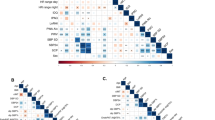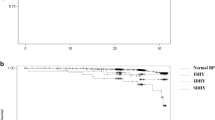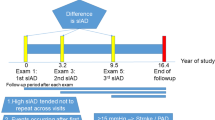Abstract
Little is known about the potential progression of hypertensive patients towards isolated systolic hypertension (ISH) and about the phenotypes associated with the development of this condition. Aim of this study was to detect predictors of evolution towards ISH in patients with initial systolic–diastolic hypertension. We selected 7801 hypertensive patients free of prevalent cardiovascular (CV) diseases or severe chronic kidney disease and with at least 6-month follow-up from the Campania Salute Network. During 55±44 months of follow-up, incidence of ISH was 21%. Patients with ISH at the follow-up were significantly older (P<0.0001), had longer duration of hypertension, higher prevalence of diabetes and were more likely to be women (all P<0.0001). They exhibited higher baseline left ventricular mass index (LVMi), arterial stiffness (pulse pressure/stroke index), relative wall thickness (RWT) and carotid intima-media thickness (IMT; all P<0.001). Independent predictors of incident ISH were older age (odds ratio (OR)=1.14/5 years), female gender (OR=1.30), higher baseline systolic blood pressure (OR=1.03/5 mm Hg), lower diastolic blood pressure (OR=0.89/5 mm Hg), longer duration of hypertension (OR=1.08/5 months), higher LVMi (OR=1.02/5 g m−2.7), arterial stiffness (OR=2.01), RWT (OR=1.02), IMT (OR=1.19 mm−1; all P<0.0001), independently of antihypertensive treatment, obesity, diabetes and fasting glucose (P>0.05). Our findings suggest that ISH is a sign of aggravation of the atherosclerotic disease already evident by the target organ damage. Great efforts should be paid to prevent this evolution and prompt aggressive therapy for arterial hypertension should be issued before the onset of target organ damage, to reduce global CV risk.
This is a preview of subscription content, access via your institution
Access options
Subscribe to this journal
Receive 12 digital issues and online access to articles
$119.00 per year
only $9.92 per issue
Buy this article
- Purchase on SpringerLink
- Instant access to full article PDF
Prices may be subject to local taxes which are calculated during checkout

Similar content being viewed by others
References
Franklin SS, Gustin W, Wong ND, Larson MG, Weber MA, Kannel WB et al. Hemodynamic patterns of age-related changes in blood pressure: the Framingham Heart Study. Circulation 1997; 96: 308–315.
Danaei G, Finucane MM, Lin JK, Singh GM, Paciorek CJ, Cowan MJ et al. Global Burden of Metabolic Risk Factors of Chronic Diseases Collaborating Group (Blood Pressure). National, regional, and global trends in systolic blood pressure since 1980: systematic analysis of health examination surveys and epidemiological studies with 786 country-years and 5.4 million participants. Lancet 2011; 377 (9765): 568–577.
Timio M, Verdecchia P, Venanzi S, Gentili S, Ronconi M, Francucci B et al. Age and blood pressure changes. A 20-year follow-up study in nuns in a secluded order. Hypertension 1988; 12 (4): 457–461.
O'Rourke MF, Nichols WW . Aortic diameter, aortic stiffness, and wave reflection increase with age and isolated systolic hypertension. Hypertension 2005; 45 (4): 652–658.
O'Donnell CJ, Ridker PM, Glynn RJ, Berger K, Ajani U, Manson JE et al. Hypertension and borderline isolated systolic hypertension increase risks of cardiovascular disease and mortality in male physicians. Circulation 1997; 95 (5): 1132–1137.
Staessen JA, Gasowski J, Wang JG, Thijs L, Den Hond E, Boissel JP et al. Risks of untreated and treated isolated systolic hypertension in the elderly: meta-analysis of outcome trials. Lancet 2000; 357 (9257): 724.
Staessen JA, Fagard R, Thijs L, Celis H, Arabidze GG, Birkenhäger WH et al. Randomised double-blind comparison of placebo and active treatment for older patients with isolated systolic hypertension. The Systolic Hypertension in Europe (Syst-Eur) Trial Investigators. Lancet 1997; 350 (9080): 757–764.
Franklin SS, Pio JR, Wong ND, Larson MG, Leip EP, Vasan RS et al. Predictors of new-onset diastolic and systolic hypertension: the Framingham Heart Study. Circulation 2005; 111 (9): 1121–1127.
Izzo R, de Simone G, Chinali M, Iaccarino G, Trimarco V, Rozza F et al. Insufficient control of blood pressure and incident diabetes. Diabetes Care 2009; 32 (5): 845–850.
de Simone G, Izzo R, Aurigemma GP, De Marco M, Rozza F, Trimarco V et al. Cardiovascular risk in relation to a new classification of hypertensive left ventricular geometric abnormalities. J Hypertens 2015; 33 (4): 745–754.
De Luca N, Izzo R, Iaccarino G, Malini PL, Morisco C, Rozza F et al. The use of a telematic connection for the follow-up of hypertensive patients improves the cardiovascular prognosis. J Hypertens 2005; 23 (7): 1417–1423.
American Diabetes Association. Standards of medical care in Diabetes-2014. Diabetes Care 2014; 37 (Suppl 1): S14–S80.
Clinical guidelines on the identification, evaluation, and treatment of overweight and obesity in adults: executive summary. Expert Panel on the Identification, Evaluation and Treatment of Overweight in Adults. Am J Clin Nutr 1998; 68 (4): 899–917.
National Kidney Foundation. K/DOQI clinical practice guidelines for chronic kidney disease: evaluation, classification, and stratification. Am J Kidney Dis 2002; 39 (2 Suppl 1): S1–266.
ESH/ESC Task Force for the Management of Arterial Hypertension.. 2013 Practice guidelines for the management of arterial hypertension of the European Society of Hypertension (ESH) and the European Society of Cardiology (ESC): ESH/ESC Task Force for the Management of Arterial Hypertension. J Hypertens 2013; 31 (10): 1925–1938.
de Simone G, Izzo R, Chinali M, De Marco M, Casalnuovo G, Rozza F et al. Does information on systolic and diastolic function improve prediction of a cardiovascular event by left ventricular hypertrophy in arterial hypertension?. Hypertension 2010; 56 (1): 99–104.
Izzo R, de Simone G, Trimarco V, Gerdts E, Giudice R, Vaccaro O et al. Hypertensive target organ damage predicts incident diabetes mellitus. Eur Heart J 2013; 34 (44): 3419–3426.
Lang RM, Bierig M, Devereux RB, Flachskampf FA, Foster E, Pellikka PA et al. Recommendations for chamber quantification: a report from the American Society of Echocardiography's Guidelines and Standards Committee and the Chamber Quantification Writing Group, developed in conjunction with the European Association of Echocardiography, a branch of the European Society of Cardiology. J Am Soc Echocardiogr 2005; 18: 1440–1463.
de Simone G, Daniels SR, Devereux RB, Meyer RA, Roman MJ, de Divitiis O et al. Left ventricular mass and body size in normotensive children and adults: assessment of allometric relations and impact of overweight. J Am Coll Cardiol 1992; 20 (5): 1251–1260.
Ganau A, Devereux RB, Roman MJ, de Simone G, Pickering TG, Saba PS et al. Patterns of left ventricular hypertrophy and geometric remodeling in essential hypertension. J Am Coll Cardiol 1992; 19 (7): 1550–1558.
de Simone G, Devereux RB, Ganau A, Hahn RT, Saba PS, Mureddu GF et al. Estimation of left ventricular chamber and stroke volume by limited M-mode echocardiography and validation by two-dimensional and Doppler echocardiography. Am J Cardiol 1996; 78 (7): 801–807.
de Simone G, Devereux RB, Daniels SR, Mureddu G, Roman MJ, Kimball TR et al. Stroke volume and cardiac output in normotensive children and adults. Assessment of relations with body size and impact of overweight. Circulation 1997; 95 (7): 1837–1843.
Casalnuovo G, Gerdts E, De Simone G, Izzo R, De Marco M, Giudice R et al. Arterial stiffness is associated with carotid atherosclerosis in hypertensive patients (the campania salute network). Am J Hypertens 2012; 25 (7): 739–745.
Franklin SS, Jacobs MJ, Wong ND, L'Italien GJ, Lapuerta P . Predominance of isolated systolic hypertension among middle-aged and elderly US hypertensives: analysis based on National Health and Nutrition Examination Survey (NHANES) III. Hypertension 2001; 37 (3): 869–874.
Kannel WB, Gordon T, Schwartz MJ . Systolic versus diastolic blood pressure and risk of coronary heart disease. The Framingham Study. Am J Cardiol 1971; 27 (4): 335–346.
Kannel WB, Dawber TR, Sorlie P, Wolf PA . Components of blood pressure and risk of atherothrombotic brain infarction: the Framingham Study. Stroke 1976; 7 (4): 327–331.
Devereux RB, Alderman MH . Role of preclinical cardiovascular disease in the evolution from risk factor exposure to development of morbid events. Circulation 1993; 88: 1444–1455.
Fagard RH, Staessen JA, Thijs L, Gasowski J, Bulpitt CJ, Clement D et al. Response to antihypertensive therapy in older patients with sustained and nonsustained systolic hypertension. Systolic Hypertension in Europe (Syst-Eur) Trial Investigators. Circulation 2000; 102 (10): 1139–1144.
De Simone G, Devereux RB, Izzo R, Girfoglio D, Lee ET, Howard BV et al. Lack of reduction of left ventricular mass in treated hypertension: the strong heart study. J Am Heart Assoc 2013; 2 (3): e000144.
Weber MA, Schiffrin EL, White WB, Mann S, Lindholm LH, Kenerson JG et al. Clinical practice guidelines for the management of hypertension in the community a statement by the American Society of Hypertension and the International Society of Hypertension. J Hypertens 2014; 32 (1): 3–15.
Acknowledgements
The authors are indebted to the nurses Stanislao Marigliano, Giuseppe Napolitano, Francesco Scarici, Antonio Scognamiglio and Ester Maria Tessitore for their invaluable support in the patients’ management, and to their coordinator Anna Vitiello.
Author information
Authors and Affiliations
Corresponding author
Ethics declarations
Competing interests
The authors declare no conflict of interest.
Rights and permissions
About this article
Cite this article
Esposito, R., Izzo, R., Galderisi, M. et al. Identification of phenotypes at risk of transition from diastolic hypertension to isolated systolic hypertension. J Hum Hypertens 30, 392–396 (2016). https://doi.org/10.1038/jhh.2015.91
Received:
Revised:
Accepted:
Published:
Issue date:
DOI: https://doi.org/10.1038/jhh.2015.91
This article is cited by
-
Vascular function in hypertension: does gender dimension matter?
Journal of Human Hypertension (2023)
-
Primum non nocere
Journal of Human Hypertension (2020)



